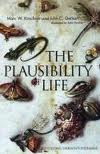 |
minireview
|
|
Marc Kirschner & John Gerhart (2005)
The Plausibility of Life - Resolving Darwin's dilemma
Yale University Press, hardback 314 pp.
|
A step in the right direction
Explaining how Darwinian evolution could create the great diversity of animals
A mini review of 'The Plausibility of Life' by Gert Korthof. First published: 10 Oct 2005
 |
Darwin explained the origin of species and their adaptations by variation and natural selection.
However, he could not explain the origin of variation. This was Darwin's dilemma: how can small, random genetic changes be converted into complex useful innovations? This is the central quesiton of the book.
In this book the authors propose a major new scientific theory: facilitated variation that deals with the means of producing useful variation and novelty.
The theory of facilitated variation is an addition to the neo-Darwinian theory of evolution. Opponents of evolution have retreated to a pecular corner of criticism that questions the origin of novel traits. However, some of their favorite claims convert to strong arguments for evolution when one includes lessons from facilitated variation. The book is aimed at scientists as well as nonscientists.
I think chapter 5, 'Exploratory behavior', is the most clear and important chapter.
|
Reviews
Further Reading
- Marc Kirschner & John Gerhart (1997) Cells, embryos and evolution: toward a cellular and developmental understanding of phenotypic variation and evolutionary adaptability. This book has been recommended by Nobel Prize winner Christiane Nüsslein-Volhard: "Marc Kirschner & John Gerhart describe insightful aspects of evolution of developmental mechanisms" (in the Preface of her book Coming to Life: How Genes Drive Development, 2006). Being recommended by a Nobel prize winner means a lot. But it means even more, because she only recommends 2 other books in the preface and there is no literature list.
- Nipam H. Patel (2006) 'How to build a lionger beak', Nature, 3 Aug 06, 515
- Abzhanov et al (2006) 'The calmodulin pathway and evolution of elongated beak morphology in Darwin's finches', Nature, 3 Aug 2006, 563-566.
- Michael Lynch (2007) 'The frailty of adaptive hypotheses for the origins of organismal complexity', PNAS, 9 May 2007, open access pdf.
-
"[Many biologists] claim to be in possession of novel insights into the evolution of complexity. The claims are often spectacular. For example, Kirschner and Gerhart (The Plausibility of Life) argue that evolutionary biology has been 'woefully inadequate' with respect to understanding the origins of complexity and promise "an original solution to the long-standing puzzle of how small random genetic
change can be converted into complex, useful innovations." However, this book and many others like it provide few references to work done by evolutionary biologists, making it difficult to understand the perceived areas of inadequacy, and many of the ideas promoted are known to be wrong, making it difficult to appreciate the novelty."
- John Gerhart and Marc Kirschner (2007) The theory of facilitated variation, PNAS, Published online before print May 9, 2007 (free access)
- Abstract: "This theory concerns the means by which animals generate phenotypic variation from genetic change. Most anatomical and physiological traits that have evolved since the Cambrian are, we propose, the result of regulatory changes in the usage of various members of a large set of conserved core components that function in development and physiology. Genetic change of the DNA sequences for regulatory elements of DNA, RNAs, and proteins leads to heritable regulatory change, which specifies new combinations of core components, operating in new amounts and states at new times and places in the animal. These new configurations of components comprise new traits. The number and kinds of regulatory changes needed for viable phenotypic variation are determined by the properties of the developmental and physiological processes in which core components serve, in particular by the processes' modularity, robustness, adaptability, capacity to engage in weak regulatory linkage, and exploratory behavior. These properties reduce the number of regulatory changes needed to generate viable selectable phenotypic variation, increase the variety of regulatory targets, reduce the lethality of genetic change, and increase the amount of genetic variation retained by a population. By such reductions and increases, the conserved core processes facilitate the generation of phenotypic variation, which selection thereafter converts to evolutionary and genetic change in the population. Thus, we call it a theory of facilitated phenotypic variation."
- Michael Behe (2007) The edge of evolution, p.187, extensively misuses Marc Kirschner & John Gerhart's book for his own purposes.
|
|


